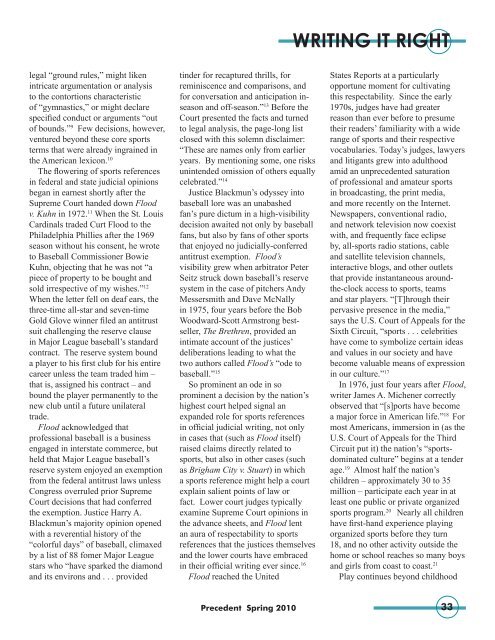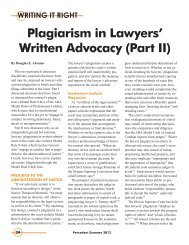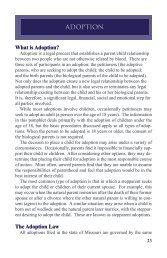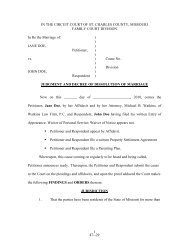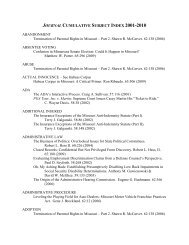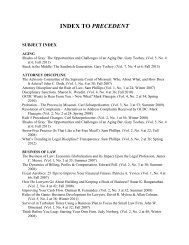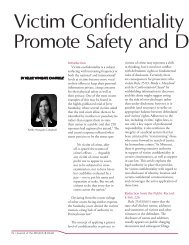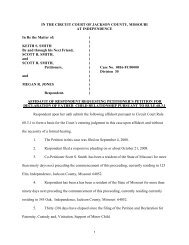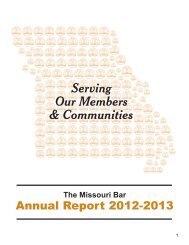Complete Precedent - the Missouri Bar
Complete Precedent - the Missouri Bar
Complete Precedent - the Missouri Bar
Create successful ePaper yourself
Turn your PDF publications into a flip-book with our unique Google optimized e-Paper software.
WRITING IT RIGHT<br />
legal “ground rules,” might liken<br />
intricate argumentation or analysis<br />
to <strong>the</strong> contortions characteristic<br />
of “gymnastics,” or might declare<br />
specified conduct or arguments “out<br />
of bounds.” 9 Few decisions, however,<br />
ventured beyond <strong>the</strong>se core sports<br />
terms that were already ingrained in<br />
<strong>the</strong> American lexicon. 10<br />
The flowering of sports references<br />
in federal and state judicial opinions<br />
began in earnest shortly after <strong>the</strong><br />
Supreme Court handed down Flood<br />
v. Kuhn in 1972. 11 When <strong>the</strong> St. Louis<br />
Cardinals traded Curt Flood to <strong>the</strong><br />
Philadelphia Phillies after <strong>the</strong> 1969<br />
season without his consent, he wrote<br />
to Baseball Commissioner Bowie<br />
Kuhn, objecting that he was not “a<br />
piece of property to be bought and<br />
sold irrespective of my wishes.” 12<br />
When <strong>the</strong> letter fell on deaf ears, <strong>the</strong><br />
three-time all-star and seven-time<br />
Gold Glove winner filed an antitrust<br />
suit challenging <strong>the</strong> reserve clause<br />
in Major League baseball’s standard<br />
contract. The reserve system bound<br />
a player to his first club for his entire<br />
career unless <strong>the</strong> team traded him –<br />
that is, assigned his contract – and<br />
bound <strong>the</strong> player permanently to <strong>the</strong><br />
new club until a future unilateral<br />
trade.<br />
Flood acknowledged that<br />
professional baseball is a business<br />
engaged in interstate commerce, but<br />
held that Major League baseball’s<br />
reserve system enjoyed an exemption<br />
from <strong>the</strong> federal antitrust laws unless<br />
Congress overruled prior Supreme<br />
Court decisions that had conferred<br />
<strong>the</strong> exemption. Justice Harry A.<br />
Blackmun’s majority opinion opened<br />
with a reverential history of <strong>the</strong><br />
“colorful days” of baseball, climaxed<br />
by a list of 88 fomer Major League<br />
stars who “have sparked <strong>the</strong> diamond<br />
and its environs and . . . provided<br />
tinder for recaptured thrills, for<br />
reminiscence and comparisons, and<br />
for conversation and anticipation inseason<br />
and off-season.” 13 Before <strong>the</strong><br />
Court presented <strong>the</strong> facts and turned<br />
to legal analysis, <strong>the</strong> page-long list<br />
closed with this solemn disclaimer:<br />
“These are names only from earlier<br />
years. By mentioning some, one risks<br />
unintended omission of o<strong>the</strong>rs equally<br />
celebrated.” 14<br />
Justice Blackmun’s odyssey into<br />
baseball lore was an unabashed<br />
fan’s pure dictum in a high-visibility<br />
decision awaited not only by baseball<br />
fans, but also by fans of o<strong>the</strong>r sports<br />
that enjoyed no judicially-conferred<br />
antitrust exemption. Flood’s<br />
visibility grew when arbitrator Peter<br />
Seitz struck down baseball’s reserve<br />
system in <strong>the</strong> case of pitchers Andy<br />
Messersmith and Dave McNally<br />
in 1975, four years before <strong>the</strong> Bob<br />
Woodward-Scott Armstrong bestseller,<br />
The Brethren, provided an<br />
intimate account of <strong>the</strong> justices’<br />
deliberations leading to what <strong>the</strong><br />
two authors called Flood’s “ode to<br />
baseball.” 15<br />
So prominent an ode in so<br />
prominent a decision by <strong>the</strong> nation’s<br />
highest court helped signal an<br />
expanded role for sports references<br />
in official judicial writing, not only<br />
in cases that (such as Flood itself)<br />
raised claims directly related to<br />
sports, but also in o<strong>the</strong>r cases (such<br />
as Brigham City v. Stuart) in which<br />
a sports reference might help a court<br />
explain salient points of law or<br />
fact. Lower court judges typically<br />
examine Supreme Court opinions in<br />
<strong>the</strong> advance sheets, and Flood lent<br />
an aura of respectability to sports<br />
references that <strong>the</strong> justices <strong>the</strong>mselves<br />
and <strong>the</strong> lower courts have embraced<br />
in <strong>the</strong>ir official writing ever since. 16<br />
Flood reached <strong>the</strong> United<br />
States Reports at a particularly<br />
opportune moment for cultivating<br />
this respectability. Since <strong>the</strong> early<br />
1970s, judges have had greater<br />
reason than ever before to presume<br />
<strong>the</strong>ir readers’ familiarity with a wide<br />
range of sports and <strong>the</strong>ir respective<br />
vocabularies. Today’s judges, lawyers<br />
and litigants grew into adulthood<br />
amid an unprecedented saturation<br />
of professional and amateur sports<br />
in broadcasting, <strong>the</strong> print media,<br />
and more recently on <strong>the</strong> Internet.<br />
Newspapers, conventional radio,<br />
and network television now coexist<br />
with, and frequently face eclipse<br />
by, all-sports radio stations, cable<br />
and satellite television channels,<br />
interactive blogs, and o<strong>the</strong>r outlets<br />
that provide instantaneous around<strong>the</strong>-clock<br />
access to sports, teams<br />
and star players. “[T]hrough <strong>the</strong>ir<br />
pervasive presence in <strong>the</strong> media,”<br />
says <strong>the</strong> U.S. Court of Appeals for <strong>the</strong><br />
Sixth Circuit, “sports . . . celebrities<br />
have come to symbolize certain ideas<br />
and values in our society and have<br />
become valuable means of expression<br />
in our culture.” 17<br />
In 1976, just four years after Flood,<br />
writer James A. Michener correctly<br />
observed that “[s]ports have become<br />
a major force in American life.” 18 For<br />
most Americans, immersion in (as <strong>the</strong><br />
U.S. Court of Appeals for <strong>the</strong> Third<br />
Circuit put it) <strong>the</strong> nation’s “sportsdominated<br />
culture” begins at a tender<br />
age. 19 Almost half <strong>the</strong> nation’s<br />
children – approximately 30 to 35<br />
million – participate each year in at<br />
least one public or private organized<br />
sports program. 20 Nearly all children<br />
have first-hand experience playing<br />
organized sports before <strong>the</strong>y turn<br />
18, and no o<strong>the</strong>r activity outside <strong>the</strong><br />
home or school reaches so many boys<br />
and girls from coast to coast. 21<br />
Play continues beyond childhood<br />
<strong>Precedent</strong> Spring 2010<br />
33


